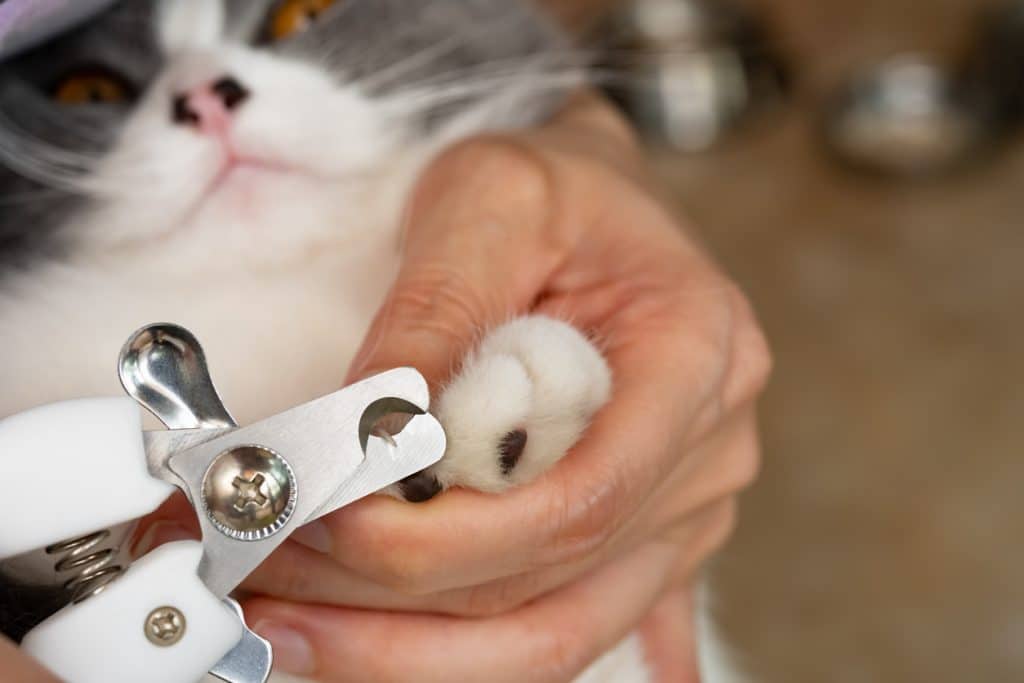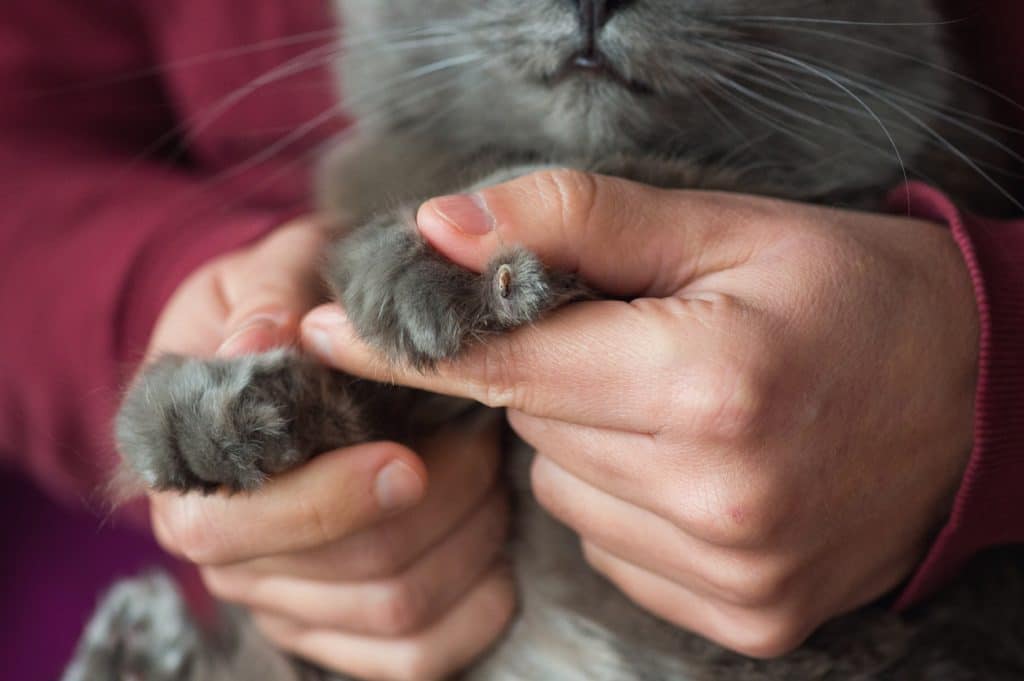Just as humans cut or file their nails, it’s important to keep your cat’s nails trimmed and tidy too. Doing so can help prevent them from scratching you (or your furniture!), but it’s also essential for your cat’s health. Furthermore, regular cat nail trimming is also a safe and effective alternative to having your feline declawed — which can lead to everything from infection and nerve trauma to behavioral issues and chronic pain.
You don’t need much to complete the task, simply a pair of cat clippers (and a dash of patience!). More good news: If you wield those clippers correctly, your cat won’t feel any pain. Read on to learn how to cut cat nails safely and properly.

iStock/Daria Kulkova
How To Cut Cat Nails: Step-By-Step
Ready to get started? “The secret here is to take your time; do not jump to the next step until the cat is comfortable with the previous one,” Cuevas Moreno states.
- Once your cat is in a comfortable position, get them comfortable around the clippers. “Desensitize the cat to the clippers, let it see them and smell them,” says Cuevas Moreno. “Touch the cat’s body with the clippers, and give a treat for calm behavior.”
- Next, “get your cat used to you touching its paw and applying pressure to expose the nail,” Cuevas Moreno explains. You can also use this opportunity to locate the quick of the nail (read on for why this is important). “If the cat remains calm and allows you to expose its claw, offer a treat and stop the session,” she adds.
- If your cat remains happy, bring the clippers close to the claw and give another treat, says Cuevas Moreno. “Repeat steps 1 and 2 at random times, changing the feet and the exposed claw,” she continues. “Your goal is for the cat to remain calm and allow you to touch, expose its claw, and get clippers near. Do not push beyond its limits.”
- All set? It’s time to snip. “Once the cat is confident, trim one claw,” Cuevas Moreno shares. “Clip in one smooth motion from top to bottom, rather than from side to side,” she adds, as “your cat will feel less pressure.” Don’t forget to reward with a treat.
- “If you feel the cat is confident, attempt to do two claws in one session and gradually work your way up,” reveals Cuevas Moreno. “Over time, the cat will allow all its claws [to be] trimmed in one session,” she adds — but until that point, keep the experience positive for all involved by going slow.
Additional tips
- Get comfy. “Choose a position most comfortable for your cat — this might be laying in your lap or on their favorite napping perch,” Mize shares.” Some cats enjoy being lightly wrapped in a towel to keep them situated — a ‘kitty purrito’, as we sometimes call it!”
- Less is more. “Never cut too short,” Cuevas Moreno notes. “Cut only a few millimeters from the tip.”
- Partner up. Having a friend or family member hold and keep the cat calm can help.
- Have treats on standby. We all like getting rewards, and cats are no different. “Use your cat’s favorite treats or toys to distract them from the process. You’d be surprised how many cats can be bribed with a worthy distraction!” says Mize.
- Out of sight doesn’t mean out of mind. If your cat has long hair, gently use your thumb or finger to sweep it out of the way and hold it back during clipping.
- Find a quiet place. Your feline will be easily distracted or spooked if surrounded by loud noises or lots of action — so turn the T.V. off or ask the kids to move to another room.

iStock/Freer Law
Common Mistakes To Avoid While Cutting Your Cat’s Nails
As with all intricate, fiddly tasks, it’s easy to slip or make mistakes.
Don’t trim too far
Trimming too much off means you’ll hit the quick of the nail, which is very painful and will cause bleeding. If this does happen, “use Styptic powder to stop the bleeding,” suggests Cuevas Moreno.
Don’t spend too long trimming their nails
Some cat owners rush to get the job done — but think of this grooming task as more of a marathon rather a sprint. “Some cats only will tolerate one paw, or even a few toes, at once,” reveals Mize.”That’s OK! Just space out nail trims. If your adult cat is a beginner, keep sessions short — under two minutes, ideally.”
Don’t press too hard on your cat’s paws
Think you need to press hard on the paw to encourage that nail out? Not the case. “Apply gentle pressure to the top and bottom of the toe to extend the nail,” Mize states. Go in hard, and your cat is more likely to become distressed and lash out.
How Often Should I Trim My Cat’s Nails?
The time between nail trims vary. “There is nothing written in stone,” states Paola Cuevas Moreno, MVZ, and animal behaviorist. “On average, you will need to trim your cat’s claws every two to four weeks, but this will depend on your cat’s habits and activities.”
If your cat is particularly active, its claws will naturally wear down. Otherwise, “if you notice your cat’s nails are quite sharp, long, and have a sharp curvature shape (approaching a circle when extracted) — it’s probably time for a nail trim,” explains Dr. Genna Mize, technical services veterinarian at Virbac.
What Happens If I Don’t Trim My Cat’s Nails?
Ensuring your cat’s nails remain a reasonable length is important for their overall health and happiness.
- If nails are too long, they can start to curl and dig into the tender pads of their paws, causing bleeding and pain.
- Lengthy nails can get caught on surfaces, causing them to painfully break.
- If nails are too long, they can become ingrown — leading to pain, inflammation, and infection.
- Expensive sofa or new dining table? Keeping your cat’s nails trimmed can help prevent damage if they use it as a scratching post.
- Trimmed nails can help take the edge off if your cat swipes at you.
If you’ve got a polydactyl cat (when they’re born with more toes than normal), their nails will likely need extra attention. This is because their additional nails can grow at odd angles, meaning they don’t get naturally filed down and are more likely to become ingrown.

iStock/cunfek
Cat Nail Clippers Vs. Human Nail Clippers
You may wonder: “Can I use human nail clippers on my cat?” While technically possible, it’s always best to use a set of cat nail clippers — they put less pressure on the nail and are specifically designed for the task.
There are various cat nail clippers, with scissor, guillotine, and plier being three of the most popular types (Don’t worry, they’re not as scary as they sound!).
- The scissor style is what you’d expect to see in human scissors, just with smaller blades. The blades can be straight, semi-circular, or a combination of both. This type is often considered easier to maneuver and grip.
- Guillotine clippers involve inserting the cat’s nail through a small hole and then pressing down on the blade to cut the end off. They offer a clean, quick cut, but some owners find them trickier to use as they involve a bit more precision.
- Similar to the scissor style, plier clippers have two blades but a slightly different handle (bar-style rather than finger holes). They also offer a lot more oomph, so only require a gentle squeeze.
“Invest in good-quality clippers that are sharp and precise,” shares Cuevas Moreno. Also, consider what you feel most comfortable using. Scissor and plier styles often have grippy handles that make them easier to hold. Some scissor clippers also come with built-in safety guards to help stop you from cutting too short.
Don’t forget to “keep the clippers clean,” says Cuevas Moreno, and “wipe them with ethanol after each use.”
What To Know Before Cutting Your Cat’s Nails
Before cutting, it’s a good idea to understand the workings of cats’ paws. The nails are naturally curved to assist with hunting, and can be ‘pulled back’ into the paw when not in use. Elsewhere, you’ll find the super cute lil’ ‘beans’ underneath the paw. They can be used to assist trimming: Gently press one, and the nail will fully pop out.
The quick is the other crucial element to be aware of, as it’s home to lots of blood vessels and nerves, so you definitely want to avoid it. Starting about halfway down, “this is the opaque part of the cat’s nail, which can be easily visualized in most cats,” Mize says. However, if your cat has darker nails, the quick can be trickier to spot — so “it is much better to err on the side of caution,” adds Cuevas Moreno.
Additionally, before you cut your cat’s nails, make sure you’ve gathered the right supplies, including a clean nail trimmer, a towel, and their favorite treats or toys as a reward for after.
Takeaway
An important element of a cat’s overall wellbeing is to keep their nail length in check — and, often, we have to give them a helping hand.
Confidence, patience, and trust are key factors in nail cutting. Once you have these sorted, the process should be relatively straightforward. However, “if you are not confident or your cat is not tolerant of nail trims, it is best to seek the help of a professional,” states Mize.
Remember to take things slow and that it’s OK to spread out a trimming session over several days. And, as they say, practice makes perfect!





